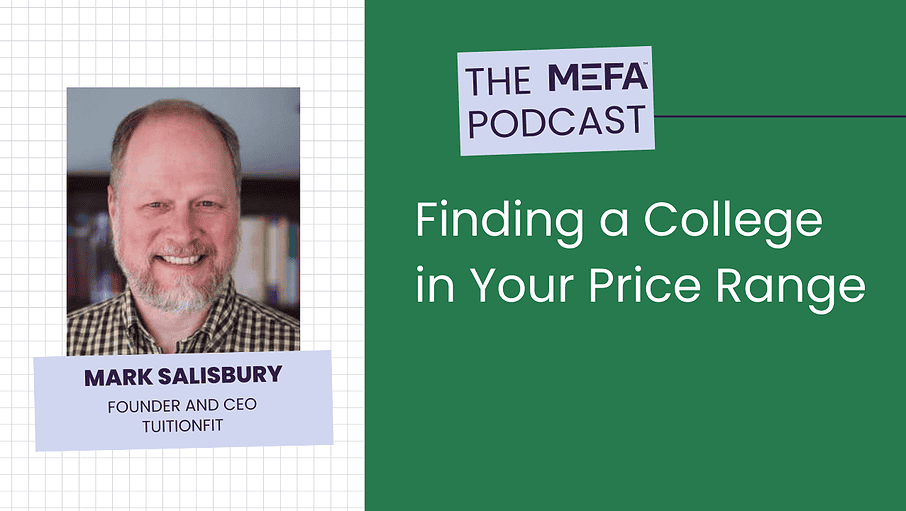

Resources Mentioned in this Episode
Jonathan Hughes: [00:00:00] Hello, everyone, and welcome to the MEFA podcast. My name is Jonathan Hughes.
Julie Shields-Rutyna: And I’m Julie Shields-Rutyna.
Jonathan Hughes: We have another great show for you on the way. Later on, Julie and I both are going to be talking to Mark Salisbury. And he is the co founder and CEO of a company called TuitionFit, which works to give high school students and their families real price information before they start applying.
So what might actual colleges cost them before they even start to apply? That’s the short version. There’s a lot more to it than that. And he was a great guest to talk to. He was lots of fun. So stick around for that. You’re going to enjoy hearing that conversation of ours. But before that, Julie, what do we have?
Julie Shields-Rutyna: Well, it was a few shows ago, I think, we talked about MEFA’s Financial Aid [00:01:00] 101 campaign starting and so this is basically all of the guidance we give to families about financial aid. And usually it’s for parents of seniors or seniors themselves, but anyone is invited to take part because sometimes we have parents of Juniors or even parents of Sophomores who join some of our webinars.
And we usually start in October because that’s when students are applying for admission or begin thinking about that and financial aid. So usually the FAFSA and the profile financial aid applications are available in October. This year, the FAFSA is delayed until December, but that’s okay. So we’re going to take a few minutes to address some of the most popular questions that we receive from folks who have started attending these webinars.
Jonathan Hughes: Yeah. And you know, I should mention the webinars, if people are interested in attending one of these, you can go and register for our Financial Aid 101 webinars at www.mefa.org. I’ve done a couple of them [00:02:00] already and they’ve been really well attended and you can just tell people are really ready.
They really want to know this information. So we’re, we’re doing these throughout the fall. So check out www.mefa.org if you want to attend. And, you know, as far as this episode is concerned, we usually do the mailbag segment where we take sort of. Questions from the public that we’ve received over the past couple of weeks and go over one of those questions in between the two main segments.
But this week, the whole thing is going to be kind of the mailbag. So we’ll instead of doing a dedicated sort of mailbag segment, we’ll skip it. But, I wanted to make sure that people had the information. If in case they do have any questions, they can reach out to us, they can email us at [email protected].
They can call us at 1-800-449-MEFA and they can reach us over social media on Facebook at @MEFAMa on X at @MEFATweets [00:03:00] and on Instagram at MEFA_MA. Okay. Any questions? That’s, that’s how you reach us. Having said all that, let’s go to our first question. And it’s one that already is by far the number one question that we have received from parents, Julie, and you know what it’s going to be.
It is, how can I apply early decision or early action to a college? If there’s no FAFSA this fall, and I don’t know what my financial aid will be. So people are really, I mean, I remember the first one that you and I did, Julie, we had that question, I think came up three or four times.
Julie Shields-Rutyna: It did. So yes, the answer to that is that many colleges that have early decision and early action programs use the CSS Profile. So that’s what, that’s the first thing. And the CSS Profile form, that’s the other financial aid application that many schools require, that is available now. It was available even right before [00:04:00] October 1st. So anyone who is applying to school, a college early decision or early action and the college requires the CSS profile, complete that and colleges are able to make estimated financial aid offers based on the information on the CSS profile.
So you will have a fairly good estimate of what financial aid you’ll be eligible for if the college uses CSS Profile. So there’s really no change there but some colleges don’t require the CSS Profile And so they’re having to do a few different things because of the FAFSA delay. Some colleges are requiring their own application.
So they’ve put together an application. You should make sure you look on the financial aid page of the college website to see if there is an institutional application. And with that, possibly some colleges will be able to make estimated financial aid offers to you. And some colleges won’t do [00:05:00] that.
And they really will just wait until you complete the FAFSA when it’s available And then give a financial aid offer. But the key is you do not need to commit to a college ever. No college is ever going to ask you to commit until you have a financial aid offer in hand. So the process may be a bit delayed in certain cases.
You will get that information eventually, and then you will be able to make your decision. So that’s, that’s there. And, and again, back to early decisions specifically, which is that binding agreement. A lot of those colleges use the CSS profile, so you will have that offer in hand.
Jonathan Hughes: That was question number one. Question number two: this is another popular question that we get. It’s not specifically tied to this year. This is one that we get all the time. And that is, it’s a question about assets and whose asset needs to be claimed, et cetera. So I’ll just go with the question. [00:06:00] If a parent has a custodial savings account with the child’s name on the account, who puts that on the FAFSA, the parent or the student?
Julie Shields-Rutyna: Let’s just start with 529 plans. 529 plans are considered a parent asset on the FAFSA, and that is a good thing. Parent assets are treated a lot more leniently than student assets. So That would be in the parent asset section.
Jonathan Hughes: Okay, so that’s 529s. What if it is a regular bank account? And that’s a question that we get a lot too. So, you say, you know, I have a bank account with my son’s name on it or my daughter’s name on it with me. Where does that go?
Julie Shields-Rutyna: Yeah, and I think you can put that. If it’s in both the parent and student’s name, I think you can put it in the parent’s name too.
Jonathan Hughes: Now, question number three: if your only parent is a legal guardian, should you apply without putting them in since you’ll be 18 when going to school? That’s confusingly worded, but I think what [00:07:00] they’re asking is, if you’re in a legal guardianship, do you have to put the legal guardian’s And then they ask because they’ll be 18 when they’re going to school. So I think there’s two separate questions there.
Julie Shields-Rutyna: Yeah. I guess what I’d say is if you have a legal guardian there’s a question on the FAFSA asking you about that, and you do not put legal guardians on the FAFSA. So if you, that means you qualify to be an independent student automatically. So just answer that question that yes.
You know, yes, you have a legal guardian and you will be considered independent, meaning you can apply for financial aid by yourself. You’ll be an independent student. So that’s one piece. And I guess I will just add being 18 doesn’t, doesn’t really factor in there because it’s, it’s all about having the legal guardian.
Jonathan Hughes: Okay. Now question number four: does the FAFSA consider expenses such as monthly mortgage or car loans?
Julie Shields-Rutyna: [00:08:00] So, no, it doesn’t. And I mean, one reason it doesn’t, it does not ask you about the worth of your primary residence, your home residence, your home. So it’s not asking you about the house that you. Own and live in at all and therefore it’s not asking about your mortgage on that property That’s just left off the FAFSA and then the FAFSA does not it also doesn’t ask questions about other expenses like that about a car loan or something so I guess all I’d say is if you have some really high expenses for certain things that are absolutely necessary That’s probably a time you want to Send an email or contact the financial aid office to see if any of those special circumstances could be considered.
But it usually has to be an expense that is a required expense in your life that maybe other people don’t have. Otherwise they’re [00:09:00] not going to just take other, other expenses into consideration.
Jonathan Hughes: All right. Now we’re getting into The FSA ID realm, which I think is probably going to be the most complicated part of the FAFSA this year.
And so the question is, do both parents need an FSA ID? I wonder if you could just sort of back up, say what an FSA ID is and why you need one, and then… Who needs one in different types of circumstances? Cause student always needs one, but which parents do?
Julie Shields-Rutyna: And FSA ID is really a username and password that will be your username and password in completing the FAFSA in connecting if you borrow any Federal loans, you’ll keep that FSA ID.
That will be your username and password forever. And so, yes, in order to complete the FAFSA. Everyone whose information is going to be on the FAFSA needs an FSA ID. So the student definitely needs an FSA ID and needs to go and [00:10:00] create one. And a parent whose information is going to be on the FAFSA, the student’s parent needs an FSA ID.
Now if the student’s two parents are married and they file a joint return, in that case One parent with an FSA ID works, but if number one, the student’s parents file separately, then both parents need an FSA ID or number two, if let’s say the student’s parents are divorced or separated, then one parent would need an FSA ID, the one who is going to complete the FAFSA, and if that parent is remarried and they’ve been They need an FSA ID too.
Jonathan Hughes: So if they file separately, right. So let’s talk about divorced or separated parents [00:11:00] then, because that’s another popular question that we always get. It’s the, it’s the next one on the, on the list. In the cases of divorced or separated parents, who needs to put their information on the FAFSA? And this is a question that I said we get every year, but it’s, The answer is different this year.
Julie Shields-Rutyna: It is. It has changed a bit. So this year it’s going to ask which parent, if the student has divorced or separated parents, which parent provided more financial support in the last 12 months. And the student will pick the parent that provided more financial support in the last 12 months. And that’s the parent who will file the FAFSA. And so we’ll leave it at that. If they say, you know, this parent, that parent, or each parent contributed exactly the same amount, it was, it was absolutely equal amount that they contributed then and supported me. Then the, the guidance is then you must pick [00:12:00] the parent with the higher income or assets. So if they can’t just pick a parent. In the first pass, if they say that’s equal, then they will be guided to pick the parent with the higher income or assets.
Jonathan Hughes: And I know that there’s a lot more to say about that because people have a lot more follow up questions, but we’ll have more to say about that, right, Julie?
Julie Shields-Rutyna: We will. And in fact, we’re going to have another episode completely dedicated to that, I think, right?
Jonathan Hughes: Yeah. We, we did an episode a few years ago with you and, and, and a colleague Susan Beard at, at Wheaton College. We did that a few years ago specifically for, you know, filing the FAFSA, filing financial aid forms really for divorced or separated parents.
And it was, I think the most popular episode that we did. We’ve done of the show and so since that answer is different now, we got to put out a new episode. So we’re going to be doing that soon. It should may, it may even be the next one. All right. Well, one more time, if you [00:13:00] have any questions on financial aid or indeed anything related to planning, saving and paying for college, don’t forget, we do have a bench of college guidance experts for you to talk to.
And I’ll give that information once again, the email is [email protected]. The phone number is 800-449-MEFA. Facebook is @MEFAMa, on X at @MEFATweets and Instagram at @MEFA_MA. Now let’s go to our talk, Julie and I, with co founder and CEO of TuitionFit, Mark Salisbury. Since 2018, Mark Salisbury has been the co founder and CEO of TuitionFit, whose stated mission is to build a world where Everyone can find a college option that’s affordable, accessible, and most importantly, that transforms the range of opportunities that awaits them after they graduate.
And also to empower the public to create real college price transparency. We’re going to get into that. In greater detail and how it can help [00:14:00] you. But first, let me welcome to the show, Mark Salisbury. Welcome.
Mark Salisbury: Thanks for having me. This is a real fun opportunity to jump on with all of you.
Jonathan Hughes: Yeah. And I want to get to TuitionFit, obviously, and what it can offer, but first, can you tell me about your background and how you came to identify kind of the need for tuition fit?
Mark Salisbury: Sure. I’ve spent my whole career working in colleges and universities and higher education. Most of it until I started this project, I was on college campuses. I was in college athletics. I was in college admissions.
I did a PhD study in how college works and how it doesn’t. Thank you. And how students learn when they don’t. And then I spent eight years with the nerdiest title in higher education: Director of Institutional Research. Which is sort of the modern day equivalent of the guy in the medieval tower [00:15:00] that has a super long beard and has all the books.
And the castle and sort of that’s the person you go to find out, you know, some spell about something. And part of the job is… Tracking data and reporting it to the federal government, reporting it to U. S. News and everybody else that wants to know, what about your school? What about X? What about Y?
And one of the things that had been so sort of amazingly crazy over my whole career was when you’re helping families and helping students try to figure out what school they want to go to. The public is very much accustomed to saying, well, what Is this school going to fit my price range? Pretty reasonable question.
And the answer that comes back is always just gobbledygook. Maybe. Kind of [00:16:00] no. Yes. But sort of. We give out millions of dollars in scholarship money to lots and lots of people. What about me? Oh, we can’t tell you that. And the public just can’t, drives them bonkers, right? And as you get down into the weeds of Higher Ed., you see all the results of this, in the context of all this other pressure to find the school that’s the most prestigious, the biggest brand name, blah, blah, blah, blah, blah, right?
And you have a whole generation of people that are drowning in student debt because they followed the basic guidance of pick a college, find the ones you fall in love with, find the ones that you just feel like they fit you when you walk on campus, and then figure out how to pay for it at the last minute.
Oh, there’s a problem. So, know all that stuff, see that monster kind of growing [00:17:00] and morphing into something crazy over my years in higher ed. And particularly through the, 2000s and 2010s, right? The kicker for me though was when I started talking to colleges and universities, especially small colleges out here in the Midwest, but could have been colleges in the Northeast, all over the place, right?
Their average discount is 65 percent off the sticker price. Way cheaper than the sticker price. And it’s exactly the price that so many middle and even lower income families are looking for when they start looking for college. And yet those colleges can’t fill their seats. And yet people are borrowing like crazy.
Like, what’s the weird mismatch? And it’s those colleges that can’t find the students, and the students can’t find them. Why? Because there’s no price transparency. And I’m a huge believer that we need higher education. [00:18:00] To function successfully, to thrive, the whole ecosystem, if we want to be a successful democracy.
And we’re not in that place right now. Arguably, the successful democracy part is also a little bit up for debate here. But the higher education ecosystem is not thriving at all. And we’ve got hundreds of small colleges that are not sure if they’re going to make it ten years from now. And… They’re in small towns and those small towns depend on those colleges for their whole success as a small community for lots of reasons.
It just seemed like this is nuts. The public hates it. The colleges hates it. We don’t have price transparency. Somebody’s got to fix this. And you know, I’m not one to nominate myself for much, but I just was at a point in my career where I thought, you know [00:19:00] what, somebody’s going to have to try this to make it work.
So I guess I’ll do it. And that was the beginning of how do we build a data set where everybody can actually see the college prices that would be for them and find the schools that are in their price range. Simple as that.
Julie Shields-Rutyna: So, Mark, you’ve said a little bit of this, but can you talk a little bit more about the effect you think. This lack of transparency in the cost of college has on people’s perception of college?
Mark Salisbury: Well, fortunately, there’s data now to back up what I think. But it is so clear now that a huge swath of lower income, middle income and bleeding into middle upper income families and students now are saying this lack of price transparency is making it so that I’m not really sure that college is worth it because the only number I know it’s going [00:20:00] to be is really expensive because those are the numbers we see, the sticker prices.
And I’m not going to walk down a process of looking at colleges, trying to figure out which ones I like, and then get stuck with a price. That’s going to blow up my future for the next 20 years. So, you know what, I’m going to look for another path that has a little bit more certainty in it. And it’s amazing how this has played out and really morphed after the pandemic.
But the pieces of it were there before where the public is just saying, look, you, you look to me. And this is not a fair thing necessarily, but it’s true from their perspective. You look to me, you, higher education, you look kind of like a scam. Because you’re asking me to sign up for something and to trust you with a whole bunch of [00:21:00] money and likely a bunch of debt, but you’re not going to tell me what my price tag is going to be. Until after I rule out 99 percent of the other options and sort of go all in with you.
Jonathan Hughes: So, now you can tell me and you can tell everybody about TuitionFit and how this seeks to address that problem.
Mark Salisbury: You know, it’s, TuitionFit is, you know, the one trick pony of one trick ponies. It was just about, can we, as a public, build?
A data set of the actual prices that colleges charge across the different types of students, and therefore the different prices the students are going to get. Well, college pricing, by and large, isn’t super complicated. It’s not like all the criteria that we hear about that relate to an admissions decision, right?
Like [00:22:00] what state you’re from, and all kinds of other factors, and whether you play the oboe, right? Like all this other stuff. College pricing really ends up being a function of. What’s your family’s financial situation, and what’s your student’s academic profile, and in certain cases, the school is so prestigious that the academic profile sort of hits the ceiling of academic caliber, and so.
The price is really just about the financial situation of the family. But in most colleges, it’s some combination of both, right? And then there’s a whole swath of colleges that need doesn’t matter. They just give everything out based on merit, right? But it’s one of those two things or a combination. So if a student has an award letter from a college.
And then the student or the family tells, out loud, what’s your EFC? Now we’re going to call it SAI, Student Aid Index. But same thing. It’s the proxy [00:23:00] for financial situation. And what’s your unweighted high school GPA? And then standardized test score, if you got one. But we can just stick with unweighted high school GPA.
And then what state do you live in? If I know those three things, and I have the financial aid offer letter from the college, Then I know that college gives that price to that kind of student. Zoom that out by several thousand. And now you get this giant matrix where you can start plotting in prices across different student types.
And you start to see which colleges give which prices to which kinds of students? And of course the challenge was who’s going to be the first person to put data in? Right because the trade off was and is if you share data you get to see all the prices in the data set from students just like you, no matter what schools they [00:24:00] got into.
And so, it’s that same give and get kind of relationship. And now that we have tens of thousands of data points, people can find all kinds of information. And when they’re at that stage of, what’s my award letter actually say? And did I get a fair price? And if like most people, the price is more than you actually wanted to pay.
What are my options? Tuition, if it’s the only place you can go to get that information. And so we built a free thing that people, that people could use to do that.
Jonathan Hughes: So this is for, sort of earlier in the process, before people start applying to colleges, right? They can go and put that info in and see what it may, you know, certain colleges charge people like them.
Mark Salisbury: So, the beauty of and the mind [00:25:00] numbingly frustrating part of the college process is that it’s Groundhog’s Day, right? Every year it’s the same cycle, over and over. And while those students that are at the late stages of the process are putting data in to compare and see. Students who are a year earlier, and sometimes those super high planners are two years earlier, are trying to build a college list of what schools fit my price range.
And so you can go to TuitionFit if you’re in that stage as well, and plug in an SAI, plug in an unweighted GPA, what state are you from, and then you’ll see this big long list of colleges that we have data from, and you’ll see, you’ll see a filter, you’ll be able to filter that by price range, so like, tell me the schools that are 20, 000 less.
Not sticker price, not average net price, but for a student like me, and we can show you. And so when you’re in that early [00:26:00] stage, you don’t really care about the price down to the penny. You just want to make sure you’re not looking at someplace that’s way out of your price range. So TuitionFit allows you to do that, and that’s a free exchange just to get data in that format.
And then as well when you are late in the process and you put your award letter in Now you’re sort of looking at it in real time What other seniors have uploaded and using that information accordingly?
Julie Shields-Rutyna: Well, I liked a couple- of I like a lot of things about this, but I like a couple of things I know we mentioned before the show that Net price calculators are out there You know on college websites for families of varying degrees of of usefulness, depending on the college and also how much work that is for a family to have to go to each college they might be slightly interested in and go through the whole process of inputting their data and receiving something back.
So the fact that they could go to one place, [00:27:00] I really like and also I really like that you are creating this from data from actual students and family awards. So I love that. Can you take us through a little bit more of this about how the student and family would do that and how you ask for that information?
Mark Salisbury: And sure, the basically the student just creates a free account. It’s literally who are you and put your email and a password in and where, you know, what state are you from? And then it’s a simple, go. What’s the award letter you got and you upload that digital image of your financial aid offer letter? We ask you a couple of other questions like what high school are you at and Just a few things to sort of confirm that that’s the actual school because as you might know, there’s more than one Loyola There’s more than one St. John’s, right? So we’ve got to make sure that we have all this lined up [00:28:00] Then once you’ve uploaded the award letter, the first thing we do is make sure it’s real.
Believe it or not, we’ve had a few people who spend a Saturday afternoon inventing a fake award letter. Like, they didn’t have their things to do, apparently. So we’ve got to make sure it’s real. Two, we redact all of the private information on that letter. Anonymize the document, right? So, any name, any temporary ID, any address, any, anything that would connect you.
That would sort of allow somebody to figure out who you are. We’re going to anonymize that. And that would include, here’s a named scholarship that’s clearly like an endowed scholarship from that school, for example. And it’s for a Hispanic male who wants to go into nursing. Okay, well we’re going to redact the name of that scholarship, right?
And then the third step is we [00:29:00] figure out what’s your actual price going to be. We’re working from the direct costs. We don’t use cost of attendance because you don’t get billed on cost of attendance. You get billed on direct costs and we want where our goal is to get to what’s your We’re going to be on your bill.
We’re going to throw out PLUS loans, we’re going to throw out work study, and anything else in there that’s not real money, that’s not as a function of your bill. Then we show you that award letter and say, is this anonymized enough for you? Are you good with this? And if you’re not, we don’t put it in the system.
Because it’s really important that you are comfortable with the anonymization. Then, usually folks are like, yeah, sure, I get it. We destroy the unredacted version that you uploaded, it goes into the system as a redacted anonymized letter, and you now can see all the offers that other students like you have gotten and have uploaded from [00:30:00] wherever they got them.
That’s that process, and it usually takes… You know 24 hours or less to do that because it doesn’t we have this process pretty well sorted out it doesn’t take too long but it’s really important that we honor trust and that the data is verifiable and When you’re using tuition fit you can click on a little image a little icon of an award letter and see the unread the sorry not unredacted the redacted letter you can see the anonymized letter from whence the data came you can test our math and fortunately we’re pretty good at math but you can check it and we’ve had people ask questions about that stuff because the word letters are so famously unclear.
Jonathan Hughes: Now, you called yourself a one trick pony or the one trick pony of one trick ponies but I was reading your [00:31:00] blog on your website as well to get a feel for the counseling and one thing that I was glad to see was that you do make a distinction between return on investment which I think everybody has a sort of dollars and cents view of return on investment and another concept that is important in this whole process and important to us, something we talk about a lot, which is fit.
And can you talk about you know, the difference between those two things and how students can evaluate that?
Mark Salisbury: Sure. I think it’s a really important distinction to make. I start with I think really an important sort of premise, which is the whole point of whatever you do after high school is to launch as a successful.
Independent thriving young adult. So everything’s about getting to that. It’s not just about which college you go to, right? So we set [00:32:00] that as the outcome. Then we talk about all of the things that go into how you’re going to set yourself up to be in the best position To launch that way, knowing that there’s stuff you control and there’s stuff you don’t control.
One lens that matters a ton, but it’s only one of the multiple lenses, is ROI. When you frame ROI as just about the money, which is what most people end up doing. Right? I would argue you could sort of, you could say that ROI is way more than that. But the tendency for a lot of us and the folks in the Higher Ed. space is to sort of zoom it in on dollars and cents.
Okay, so let’s, let’s sort of give those people that, right? It matters a ton that you think about that, right? Because otherwise, thriving, independent, successful adult, probably not going to happen. Even if you graduate. [00:33:00] And you’re, you’re launched as a wonderful teacher with 300, 000 in debt. It doesn’t- it doesn’t work.
That equation will not work and you will not be a teacher. But fit, that really sort of brings in all of the other stuff that ultimately should translate into you being a healthy, thriving person, right? ROI is about more than just money, in my mind. It’s about you having a sense of your own purpose, your own growth, your sense of your own ability to give yourself momentum going forward.
Right? Your ability to have flexibility to choose options and to weigh those options to understand the nuance. And that means in the world that we live in, you’re going to have to develop a whole lot of interpersonal skills, a whole lot of really nuanced [00:34:00] abilities to manage in the society that we live in.
And that stuff is all related to things way beyond money, although they’re not necessarily totally independent of that, but it’s way beyond money. So, then we start to talk about fit. Now the part about fit that I think people need to really ask a lot about is You’re going to change while you’re in college, please, I hope.
You’re going to change if you’re breathing, you’re paying attention, you’re probably going to change some, right? And the college probably isn’t, right? Like, that’s the thing with higher ed. Like, DNA of Higher Ed. is to not change, right? Stay in the thing. So, if you get too focused on fit, you can start fitting yourself at, to a college at age 18 when, what about when you’re 22?
Like, is that college not going to be a good fit at 22? So, [00:35:00] you kind of need to think about fit in this pretty complex way that is, recognize that it exists, recognize that it matters, recognize the kind of person you are and the kind of environment that you would fit well into, yet would stretch you a bit.
But not swing too far on either side of that equation, right? Like, literally doesn’t matter, put on blindfold and throw a dart at a map, and I’m going to that school. Or, oh my god, if I don’t find the exact perfect school, I’m going to be a useless person under a bridge somewhere for the rest of my life. Like, no, it’s not either of those, right?
You can’t ignore it, you can’t obsess over it. But if you just talk about ROI, you’ve missed an incredibly important part of the puzzle, and then you’ve got to really understand the nuance. And the limitations of fit, but you have to [00:36:00] focus on that, too.
Julie Shields-Rutyna: Thank you. I think that this part of the conversation was really important for people to hear. I appreciate that.
Mark Salisbury: I do think that you have to order these things, though. You can’t just sort of throw them all on a wall and just, you know, take them in whatever order you want. That’s caused an awful lot of the problem here, right? The traditional way of doing the college search, and 40 years ago when the sticker price is what everybody paid.
It was fine to sort of pick your college Then as a function of that you you’re looking at the price tag That’s shaping what you think and then you can figure out how to pay for it once you get in But you’ve used price as a way to think about it and you’ve had that data point today If you just pick your dream college And don’t think about cost first.
This is a marketplace in which the sellers are trying to get [00:37:00] you to want to come there. So they’re really looking to pull all the emotional strings. It’s not because they’re bad people. It’s just because it’s a marketplace. And they’re selling something, right? We would all do the same thing if we were working at a college.
Because we got to get butts in seats and we got to keep the lights on. But they’re trying to drive an emotional reaction to get you to fall for them. And you’re trying to make a rational decision. So I would argue that unless you are wonderfully affluent, financial fit needs to be the first lens you start with.
It has to be the first one. And you can, everybody can make a different choice. over what their financial fit really is, what their price range really is, but you have to be honest about that and face that first. And then you can proceed because the truth of the matter is there’s colleges [00:38:00] in every price range.
It’s not true that all colleges are too expensive for everybody. That’s just not true. It doesn’t mean that all colleges are totally affordable for everybody either, but it’s absolutely the case that there are a bunch of colleges that are too expensive for most people, and then there’s a bunch of colleges that are in the right price range for a bunch of people, and then there’s a bunch of colleges that are affordable for almost everybody, and it’s a matter of making sure that every student finds The ones that fit their price range so that when they’re off as young adults, they have the financial flexibility to pursue whatever it is they have become.
Because they’re going to evolve in college and they’re going to grow and they’re going to change. And the worst thing we can do for young people is allow them to discover themselves and grow into this incredible young person between the ages of [00:39:00] 22 and 20, or age 18 and 23. And then when they get out of college and they go off into the world, tell them, “Oh yeah, sorry.”
You can’t really pursue who you want to be because you owe too much money. So take that soul crushing middle management job. Good luck. That’s not what we want to be.
Julie Shields-Rutyna: So what I’m hearing you say is that we, society, we pretty much have this process a little bit backwards that, and you’re saying we should determine the, our price range or a family should determine their price range first and then make that college list accordingly and that tuition fit will help them.
Mark Salisbury: You have just named the hill, the hill that I’m standing on. I’m going to plant my flag.
Julie Shields-Rutyna: How do students and families tend to find you?
Mark Salisbury: A lot of times they find us because they hear about us from their school counselors, their go to [00:40:00] people that they might talk to about college planning. They might read one of the several books out there that are sort of making the rounds about college planning stuff.
We are not a big, super well funded advertise like crazy company. We are small three person shop trying to change the world. And so people find out about us by podcasts like this one. By word of mouth and find tuition fit.org and start to use the tool.
Julie Shields-Rutyna: Well, and we, we at MEFA talk to so many students, so many parents.
So if you had to give one piece of advice to a student and one piece of advice for parents what would that be
Mark Salisbury: For the student? I would say if you are. Even mildly plugged into thinking [00:41:00] about who do I want to be several years from now and what do I got to do starting now to give me a shot at getting there.
If you’re mildly plugged into that and you stick with that mindset and then act on what you figure out. Chances are pretty high that you’re going to be great. You really are. You’re going to be great, no matter where you go. Because you’re going to stay plugged in and you’re going to be the one who makes your education happen.
And at the end of the day, when you finish and you’re out in the world, you’re going to have confidence because you’re going to say, I’m the one who made me. And isn’t that what we want everybody to feel anyway? So as a student, just plug into this. Just be thoughtful and be honest. Look in the mirror. and talk to that person.
And if you do that, your chances of success are already taking off. So that’s what I would say to students. To parents, I would say, [00:42:00] think about the young person that you have been raising all this time. You’ve been raising them to be proactive. You’ve been raising them to be resilient. You’ve been raising them to be persistent, to be thoughtful, to be kind, to be the kind of person that navigates A world that good things happen one day and bad things happen the next.
That person that you’ve raised when you send them off to college, wherever they go, with those traits, they’re going to nail it. Doesn’t mean it’s going to be perfect. Doesn’t mean it’s going to be great. It’s going to be just like high school. Today you had a great teacher. Tomorrow you have a horrible teacher. Have a relationship that sends you over the moon, and then another one breaks your heart.
Turns out that’s just the way life works. It’s going to happen no matter where you go to college and you’re going to discover stuff about yourself that you didn’t know and you’re going to have some changes that happen in what you decide you want to study and pursue and be in life. [00:43:00] But you’ve raised your children to be that way, to have all those traits already.
Trust that. Trust it. You did all that work. Now send them. It’s going to be good.
Jonathan Hughes: Well, I want to give you one more chance to repeat your, how people can get in touch with you. Your information, how students and families can find you, and it’s…
Mark Salisbury: TuitionFit is at www.tuitionfit.Org. One of the sort of unwritten rules of entrepreneurial hood ship, whatever you want to call it, is that you take two words that are meant to be separate and then you slam them together, and somehow you are allowed to do that in this world because I’m an English major from way back when, creative writing. So apparently I have poetic license. I can just throw words together and make new words. Tuition and fit slam together. org. If people have specific questions for me, they can email me and I respond [00:44:00] to every email I get, Mark, M A R K.
Jonathan Hughes: Well, I’m glad that you came down from the tower to to create TuitionFit and to talk to us. It was a pleasure to speak with you. Thank you so much for being here. It was a lot of fun.
Mark Salisbury: Great. It was a real pleasure to meet both of you.
Julie Shields-Rutyna: Thank you, Mark.
Jonathan Hughes: All right, everyone. I hope you enjoyed that. I want to thank Mark Salisbury for being here and for sharing his story and his expertise with us. And remember, folks, if you liked what you heard today and you want to know more about planning, saving and paying for college and career readiness, well, then you can follow our show.
You can find us wherever you get your podcasts and please remember to review us. It helps us to keep doing what we’re doing and getting the show out to folks like you. So Julie, thank you once again.
Julie Shields-Rutyna: Thank you, Jon.
Jonathan Hughes: I also want to thank Shaun Connolly, our producer, and AJ [00:45:00] Yee and Lauren Danz for their assistance in posting the show. Once again, my name is Jonathan Hughes and this has been the MEFA Podcast. Thank you.













